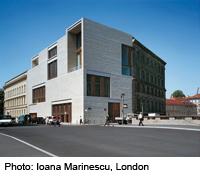Gallery Building in Berlin

Erected by the collectors, Céline and Heiner Bastian, the new gallery building has a scuptural form and occupies one of the most prominent gaps in the urban landscape of Berlin. It is set on the bank of the river opposite the Museum Island. The restrained volumetric design of the gallery takes up the eaves height and coloration of the neighbouring historical buildings. For the seemingly monochrome facade, carefully cleaned light reddish-yellow bricks from demolished buildings were reused, laid in English bond with raked-out joints. Since there were to be no vertical expansion joints in the brickwork, the outer skin had to be at least 250 mm thick, so that any reactive forces caused by changes in temperature could be absorbed without causing cracks. The bays of brickwork are defined by large openings and on each storey by horizontal sand-blasted precast concrete strips with stone additives. These elements are divided by 5 mm abutment joints. Lateral movement in the brickwork is absorbed at the reveals and the ends of the building. Vertical forces are transmitted to the concrete strips on which the walls bear without sliding joints. On the other hand, along the topmost horizontal precast concrete element at eaves level, an expansion joint was necessary to absorb vertical movement and changes in height. The joints are reinforced at particularly critical points.
The architects and the company executing the work developed a special process for the facade coating: the wall was pointed and slurried in a single operation. Coloured lime mortar was applied over the face of the brickwork and worked into the joints before being partly removed from the surface with small trowels or metal scouring devices.
The large window openings are articulated by folding shutters and frames in ipe, a tropical wood that is robust enough to be left untreated apart from the smooth, planed finish.
Folding shutters made of plywood were also used internally as a means of preventing glare. Painted white or grey, the walls and most other surfaces in the gallery spaces communicate a sense of purity and noble
elegance.
